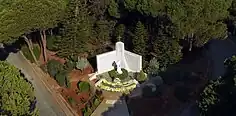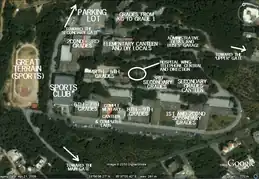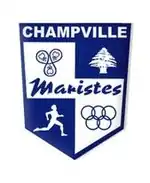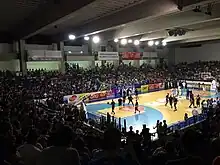Collège des Frères Maristes Champville
The Collège des Frères Maristes Champville (commonly known as "Champville") is a private Marist Roman Catholic and French-language educational institution set in Dik El Mehdi, Matn District, Lebanon. Champville is one of the two remaining Marist schools in Lebanon, the other being the Collège Mariste Notre Dame de Lourdes in Byblos.[1]
 Bird's-eye view of Champville's campus in Dik El Mehdi. | |
| Latin: Collegii Institutum Fratrum Maristarum a Scholis Campagnapolitam | |
Other name | Champville |
|---|---|
| Motto | Omnia ad Jesum Per Mariam (Latin) |
Motto in English | Everything to Jesus through Mary |
| Type | Private |
| Established | 1966 |
| Founder | Saint Marcellin Champagnat |
| Affiliation | Marist Brothers |
Religious affiliation | Roman Catholic |
| Director | Miled Hobeika, PhD |
| Students | 3,600 |
| Location | , 33°56′5.02″N 35°37′1.68″E |
| Campus | 54.3 acres (22.0 ha) |
| Language | French |
| Colours | Blue & white |
| Website | https://www.champville.edu.lb |
 | |
As a major educational institution in the country with a long and rich history, it has a strong reputation for providing quality education that has positively impacted the academic and professional success of many individuals.[2] Champville is a crucial element in preserving the culture of Lebanon and promoting its linguistic diversity.


The school was named after Saint Marcellin Champagnat, the French founder of the congregation of the Marist Brothers. The name "Champville" is derived from the French phrase "la ville de Champagnat," which translates to "the city of Champagnat."
History
Champville is a private Marist Catholic institution that is committed to serving "[...] Lebanon's youth within its rules and following the priorities set within its Educational Project".[3] It is currently administered by a group of Marist Brothers with the help of a large secular educative team.
In 1868, five Marist Brothers were initially sent from France to assist Jesuit missionaries at their seminary-college of Ghazir. The following year, three more joined them to serve at their college in Beirut. These two Jesuit seminary-colleges later merged to become the esteemed Saint Joseph University of Beirut. However, due to a shortage of personnel, exacerbated by the consequences of the Franco-Prussian war of 1870-1871, the Brothers had to withdraw in 1875.[4]
In 1895, five Brothers were sent to assist the Lazarist Fathers in Antoura, and the following year five more joined the Jesuits in Beirut. The number of Marist Brothers arriving each year varied from three to five. By 1898, the Brothers were managing an elementary school in Jounieh, and they were housed in Amcheet. In 1900, the Brothers took charge of schools in Amcheet, Achqout, and Baabdat. They were also asked to collaborate in the seminary of the Maronites in Kfarhay and in the Armenian-Catholic seminary in Bzoummar. In addition, they ran schools in Mish Mish and Baskinta, and they inaugurated their new Collège du Sacré-Cœur in Jounieh. By this time, the construction of their provincial house in Amcheet was completed, and a group of young Brothers emigrating from France had already arrived. Later that year, twenty young Brothers, ten novices, six postulants, and seven juvenists came to Lebanon where they continued their religious studies in Amcheet. They were joined by Lebanese Brothers, and the provincial house was later named "Our Lady of Lebanon."[4]
In 1904, various local communities requested the Marist Brothers' assistance. Among them, the Congregation of Our Lady of Sion, the Armenian-Catholic community, the Maronite community, and the Jesuits in Bikfaya and Sidon. In 1908, the Marists took charge of the Collège Saint-Louis in Sidon, which they later purchased in 1924. Additionally, the Marist Brothers assumed responsibility for several schools in different regions, including in Batroun, Hadath, Deir al-Qamar, Beit Chabab, and Zahlé. In the same year, the Brothers established the Collège Mariste Notre-Dame de Lourdes in Byblos. In 1911, two Brothers from Ottoman Syria founded a school in Betafo, Madagascar. However, in 1914, the Ottomans expelled foreigners and transformed Marist schools into barracks, forcing the Brothers to flee to Italy and take refuge near Turin.[4]
In 1920, only twenty Brothers were able to return from Europe and they decided to reopen nine schools, including ones in Syria (Aleppo and Damascus) and Lebanon (Batroun, Amcheet, Byblos, Jounieh, Deir al-Qamar, Sidon, and Zahlé). More Brothers arrived, and young Lebanese Christians joined the congregation. By 1939, the number of Marist Brothers in Lebanon and Syria had increased to ninety, but World War II later significantly reduced their numbers. As a result, the Brothers had to permanently withdraw from Batroun in 1952 and Deir al-Qamar in 1954, and stopped teaching in the schools of Aleppo and Damascus, which were nationalized by the Government of Syria in 1967. In 1961, the Collège Saint-Louis was transferred from Sidon to Rmeileh, where it was renamed Notre-Dame de Fátima and reached a student population of 2,000, consisting of approximately equal numbers of Christians and Muslims.[4]
In 1966, the Collège du Sacré Cœur in Jounieh was relocated to Dik el-Mehdi, and was renamed the Collège des Frères Maristes Champville. From 1975 onwards, Lebanon was plagued by clashes and a long war.[4] Champville survived the Lebanese Civil War.
Today, Marist Brothers collaborate with secular Marists to provide a Catholic education to Lebanese students.[4]
Facts and figures
Champville was founded in 1966 as a direct continuation of the Collège du Sacré-Cœur of Jounieh which was founded in 1903 by French missionaries. Its actual history dates back to 1868. It lies upon a green hill in Dik El Mehdi not far from the Embassy of the United States in Lebanon and occupies around 23 hectares of surface. There are approximately 3,000 students enrolled in the institution.[5] The school teaches fifteen academic years, divided into eight groups:

- Kindergarten (Cycle des Maternelles)
- Primary school I (Cycle des Benjamins)
- Primary school II (Cycle des Minimes)
- Primary school III (Cycle des Petits)
- Middle school I (Cycle des Moyens)
- Middle school II (Cycle des Grands)
- Secondary school (Cycle des Secondaires)
- Senior (Cycle des Terminales)
The school consistently averages highly in both French and Lebanese official examinations, and enjoys a very high standing among the Lebanese schools.
Teaching and learning
As one of the leading educational institutions in Lebanon, Champville prepares its students to two baccalaureates, the Lebanese and the French Baccalauréat. The students can opt to take the Lebanese Baccalaureate only or both. The School provides a bilingual teaching of Arabic and French from the start. In the sixth grade, the school provides mandatory English language courses. Champville gives scientific subjects the utmost importance and teaches mathematics and sciences in all preparatory classes, then mathematics, biology, physics, and chemistry in middle school. The three tracks of the baccalaureate a student can follow in the senior year are: General Sciences (with a specialization in mathematics and physics), Life Sciences (with a specialization in biology and chemistry), and Social and Economic Sciences (with a specialization in sociology and economics). There is no Linguistic baccalaureate track within the school which is why Champville has earned the reputation of a purely scientific school (French: Une école purement scientifique). In parallel, the school provides DIY training for students between the second and the eighth grades; computer studies classes between the second grade and second secondary grade; media studies between the sixth and the ninth grades; and an initiation to scientific research (French: Travail Personnel Encadré (TPE), which translates to "Personal Coached Work").
Timing
Champville stands out from the rest of Lebanese schools in that after each fifty-minutes class, the students get a ten minutes break. After the fifth class, they get a forty-minute break, during which they may head for one of the cafeterias for lunch. Students in the double baccalaureate program get four additional classes, on Tuesdays and Thursdays afternoons, in order to be able to satisfy the requirements of the two official examinations. A normal day at the school starts at 07:40 AM and ends at 03:10 PM for usual classes.

Extra-curriculars
Champville provides five options for extra-curricular activities: sports, cultural activities, scouting, Eucharistic Youth Movement (EYM) (French: Mouvement Eucharistique des Jeunes (MEJ)), and Christian Life Teaching.
Sports and cultural activities

The Sports department of Champville organizes inter-grade tournaments in football, basketball, and more ball games. Champville organizes afternoon athleticism sessions, which means that the sportsmen and sportswomen of the student body are able to train professionally with coaches after school hours. The school also teaches ballet, street dance, painting, judo, taekwondo, and aikido on Saturdays, between 9:00 AM and 12:00 PM.
The school has a basketball team that competes in the Lebanese Basketball League.
References
- "Ecoles - Marcellin Champagnat sera canonisé le 18 avril à Rome Les Maristes : un siècle de présence au Liban (photos)". L'Orient-Le Jour. 1999-04-09. Retrieved 2023-05-02.
- https://www.bluegrapesmarketing.com/upload/champville/2018.pdf
- The Collège des Frères Maristes Champville Agenda 2009 - 2010, Educational Project, Presentation of the institution.
- "À Propos | Collège des Frères Maristes Champville". www.champville.edu.lb. Retrieved 2023-05-02.
- The Collège des Frères Maristes Champville Agenda 2009 - 2010, Educational Project, Presentation of the institution.